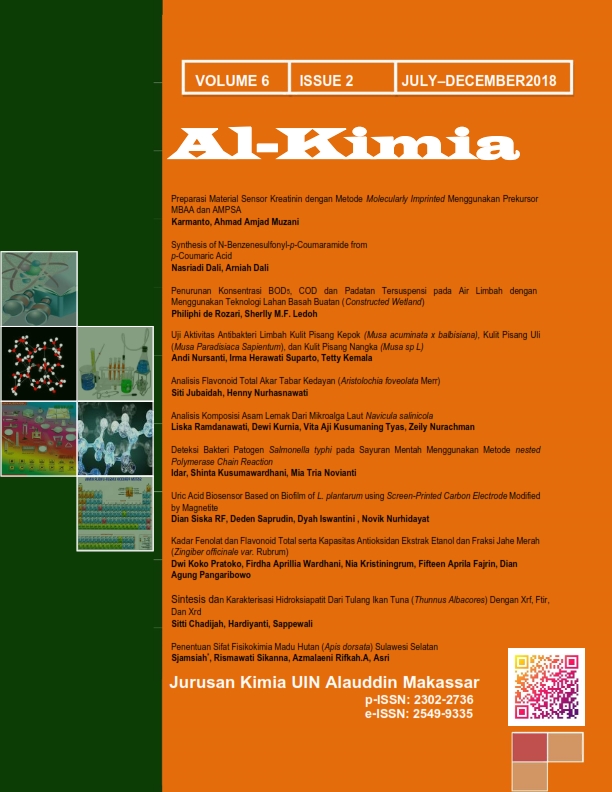Analisis Komposisi Asam Lemak dari Mikroalga Laut Navicula salinicola
Abstract
Indonesia is an aquatic country with potential biodiversity. One of the potential biodiversity is microalgae. Microalgae potential to be developed as a functional food with the characteristics of its fatty acids. The most fatty acids found in diatoms are myristic acid, palmitic acid, DHA and EPA. One of marine microalgae contain lot of fatty acids is diatom Navicula salinicola. This study was aim to analyze fatty acid composition of marine microalgae Navicula salinicola. Navicula salinicola was cultivated in Guillard medium with 2.5; 5; and 7.5 % of nitrogen composition and cultivated for 11 days. Dry biomass obtained from harvesting was used for the extraction. Extraction of lipid from microalgae used Bligh & Dyer method with 9,9%; 14.5%, and 17.5% of oil yield. Result of GC-FID analysis that were 6 types of fatty acids that identified are palmitic acid, myristic acid, pentadecanoic acid, stearic acid, palmitoleic acid and eicosapentanoic acid, EPA. The highest fatty acid was palmitic acid with fatty acids percentage were 64.04%; 65.03%; and 53.55% respectively.
Downloads
References
Barsanti, L., dan Gualtieri, P. (2006). Algae: Anatomy, Biochemistry, and Biotechnology, Taylor dan Francis Group. Florida: USA.
Hairunnisa. (2014). Aplikasi Pigmen Fotosintesis Mikroalga Laut Navicula sp. sebagai Bahan Pemeka Sel Surya, Tesis, Fakultas Matematika dan Ilmu Pengetahuan Alam Institut Teknologi Bandung.
Junaidi Ahmad, Zulfikurrahman, Abdullah, dan Gunawan. (2014). Ekstraksi Lipid dari Biomassa Synechococcus sp. dengan Metode Osmotic Shock. Sains dan Terapan Kimia, 8 (2) : 94-102.
Kawaroe, M., Prartono, T., Sunuddin, A., Sari, D. W. dan Augustine, D. (2010). Mikroalga: Potensi dan Pemanfaatan untuk Produksi Bio Bahan Bakar. Bogor: IPB Press.
Nur, M.M., dan Azimatun. (2014). Potensi Mikroalga sebagai Sumber Pangan Fungsional di Indonesia. Ekser,9 (2) : 1-6.
Setyaningsih Iriani, Hardjito Linawati, Daniel R. Monintja, M. Fedi A. Sondita, Maria Bintang, Nispi Lailati dan Lily Panggabean. (2017). Ekstraksi Senyawa Antibakteri Dari Diatom Chaetoceros gracilis dengan Berbagai Metode. Institut Pertanian Bogor: Bogor.
Copyright (c) 2018 Liska Ramdanawati

This work is licensed under a Creative Commons Attribution-NonCommercial-ShareAlike 4.0 International License.
Authors who publish with this journal agree to the following terms:
1) Authors retain copyright and grant the journal right of first publication with the work simultaneously licensed under a Creative Commons Attribution License that allows others to share the work with an acknowledgement of the work's authorship and initial publication in this journal.
2) Authors are able to enter into separate, additional contractual arrangements for the non-exclusive distribution of the journal's published version of the work (e.g., post it to an institutional repository or publish it in a book), with an acknowledgement of its initial publication in this journal.
3)Authors are permitted and encouraged to post their work online (e.g., in institutional repositories or on their website) prior to and during the submission process, as it can lead to productive exchanges, as well as earlier and greater citation of published work (See The Effect of Open Access).


